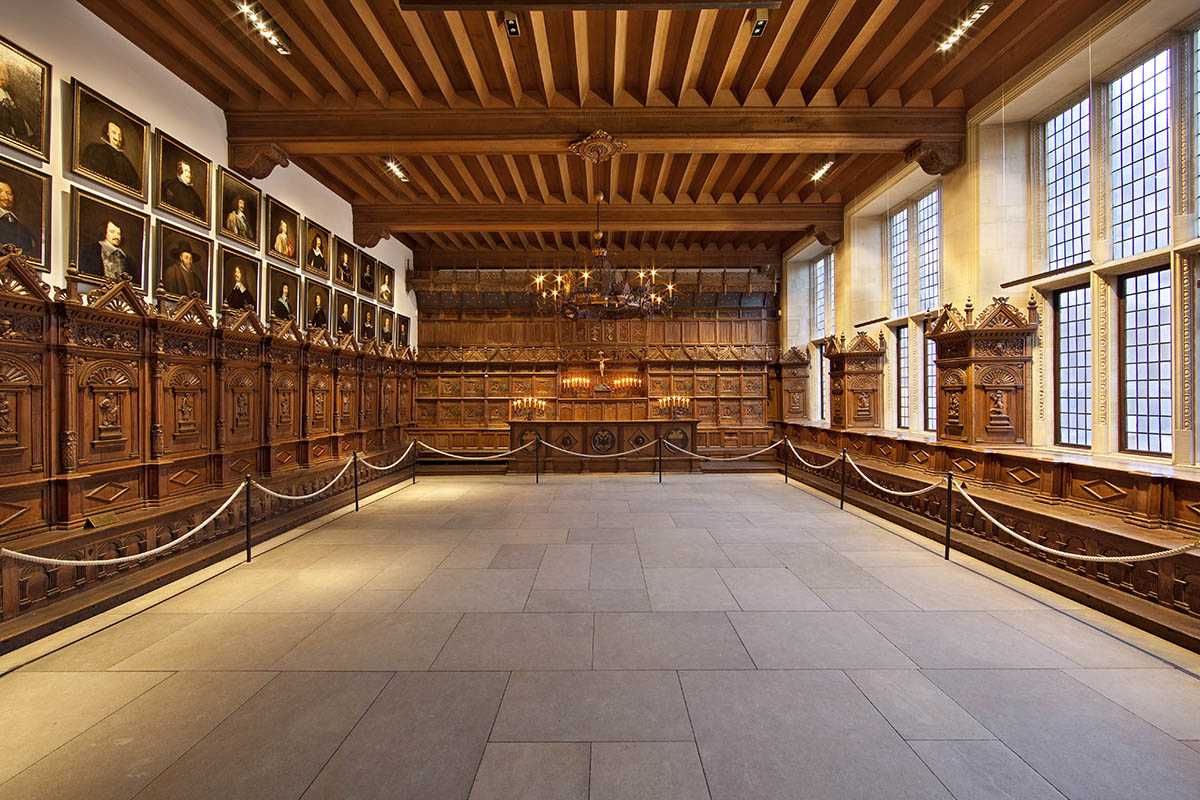The Thirty Years’ War that broke out in the Holy Roman Empire in 1618, is officially brought to an end in the town hall of Münster, a distinctive vaulted building. The Peace of Westphalia is concluded.
This means that when the G7 Foreign Ministers meet 374 years later, in 2022, for their important talks about tackling present-day challenges, they are doing so in a very special historic location.
Where is the Hall of Peace and what can I see?

The town hall with its tall gable – a Gothic building from the mid-14th century – can be accessed directly from the cathedral square. You just need to walk a few steps past the arcade, across the striking cobblestone pavement of the market square ‘Prinzipalmarkt’. Along the way, you will see cyclists, pedicabs and the occasional motorised carriage. The buzz of voices and clanking of coffee cups and drinking glasses can be heard everywhere in the heart of this Westphalian metropolis. You will enter the historic town hall via the steps on which the well-known local character ‘Uncle Willi’ used to make music that was enjoyed by locals and tourists for many years. Next you will walk across the foyer of the town hall that is now home to the tourist information office, all the way to the entrance of the Hall of Peace.
This is where, back in 1648, the Spanish-Dutch peace treaty took form that was part of the Peace of Westphalia. Owing to its historic relevance, the Hall has not been altered since 1648. However, it was rebuilt true to the original after being destroyed in World War II. All four walls feature renaissance style wood panelling that dates back to 1577. Portraits of the most important delegates, who negotiated the end of the Thirty Years’ War in Münster between 1644 and 1648, can be seen on the inside wall. In addition to the delegates, the 37 portraits also show rulers. The fireplace on the south wall features a cast-iron stove plate commemorating the peace agreement of 1648. The plate reads: “Anno 1648. Pax optima rerum, 24. Oct.” (translated freely: “Peace is the highest good, 24 October 1648.”) Among the unique items shown in the Hall is also the golden rooster – a silver vessel with ornate gilt-plating that is presented to honoured guests to the city as a ceremonial drinking cup to this day.
What makes the Hall of Peace so important?

It took tough negotiations to conclude the Peace of Westphalia that was established in the cities of Münster and Osnabrück. Five years went by, before the representatives of almost all European powers had found a solution, and the peace treaties were signed.
The Peace of Westphalia is considered a key milestone on the path towards a European peace order and the development of present-day international law. The Peace of Westphalia had an impact on all of Europe: among other things, the sovereignty and independence of the Netherlands was finalised in the Hall of Peace.
To this day, the Peace of Westphalia plays an important role in Münster: every two years, the Westphalian Peace Prize is presented in the Hall of Peace by the Economic Society for Westphalia and the Lippe Region (WWL). The prize which is worth EUR 100,000, is awarded to international personalities and institutions that have made extraordinary efforts to promote peace in Europe and around the world. Among the award winners in recent years were Kofi Annan (2008), Helmut Schmidt (2012) and King Abdullah II of Jordan (2016). Awards were also presented to various organisations, such as Children for a better world (2012) or the Action Reconciliation Service for Peace (2016).
The Hall of Peace is open to visitors and guided tours are available.
Further information: Hall of Peace
